mobile View, to the German Version tap the flag


Until the outbreak of the War of Independence, the British colonies in North America had no actual flag. At times there was a flag for New England, the six north-eastern colonies: Maine, New Hampshire, Vermont, Massachusetts, Rhode Island and Connecticut. This showed a George Cross with a tree in the upper corner, but later this flag appears as the upper corner in the Red and Blue Ensign. From 1707, the Union Jack was placed in the upper corner of the national flags of the colonies of the British Empire, i.e. the British Red Ensign had to be flown as the flag in the American colonies. It is not known whether he officially wore badges.
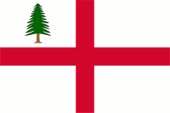
to ca. 1680,
New England (unofficial),
Source, by: Corel Draw 4



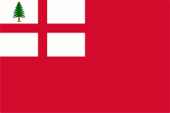
from ca. 1680,
New England (merchant flag),
Source, by: Corel Draw 4




from ca. 1707,
New England (merchant flag),
Source, by: Corel Draw 4




One first red and white striped liberty flag was used in Boston as early as July 1769, and again in 1773 on the occasion of the "Boston Tea Party". The five red stripes on the latter possibly represented the New England colonies. In October 1774, a Red Ensign with the motto "Liberty and Unity" was hoisted in Taunton, Massachusetts. Another sign of resistance was the erection of "liberty trees".

1769 & 1773,
Liberty flag "Boston model",
Source, by: perenickushistc.weebly.com



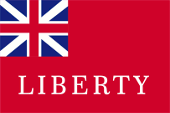
October 1774,
Liberty flag "Taunton model",
Source, by: Die Welt der Flaggen



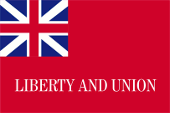
October 1774,
Liberty flag "Taunton model",
Source, by: blog.usaflagco.com






The pine tree emblem originated in New England at a very early stage and is likely to have later been equated with the tree of liberty. Another popular emblem of the time was the rattlesnake with the associated motto "Don't tread on me". The snake was a typical American symbol and was later depicted with thirteen limbs. During the initial fighting at Lexington and Concord, there was no special flag on the American side, although the "Bedford flag", which may have been an old cavalry standard from the English Civil War, was displayed on this occasion. The use of the Red Ensign with a motto in the flying end, the old Red Ensign with the pine flag in the upper corner or a simple pine flag seem to have been some of the options available to the Americans. Also considered was a rattlesnake flag as suggested by Colonel Gadsden (South Carolina). This was yellow with the rattlesnake and the motto. A regiment formed in Pennsylvania in 1775 used a red ensign with a rattlesnake badge in the flying end (Proctor's Independent Battalion, Westmoreland County). A stripe flag with rattlesnake was used by the South Carolina Navy. The ships sent from Washington to Massachusetts Bay flew the pine flag of September 1775, which bore the motto "Appeal to Heaven".
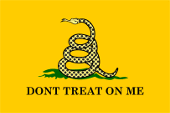
1775,
Rattlesnake flag "Gadsen model",
Source, by: portlandflag.org





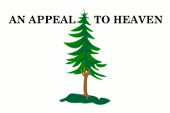
1775,
Pine tree flag "Massachusetts model",
Source, by: etc.usf.edu



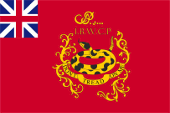
1775,
Liberty flag "Westmoreland model",
Source, by: triblive.com




When General George Washington became commander-in-chief of the army of the British colonies in America on 3rd of July in 1775, it was necessary not only to reorganise the military colonial units into a unified army, but also to adopt a common flag. Thus a flag was created with thirteen horizontal stripes – red and white – according to the number of colonies and with the British flag in the canton. Today it is called the "Grand Union" flag or "Continental Colours". The presence of the British Union Jack probably signalled that the leaders wanted to remain loyal to the British king. It may have been used on American ships as early as 3rd of December in 1775 in Philadelphia, but there is much more evidence that it was first hoisted on Prospect Hill in Cambridge, Massachusetts, where the Gontinental Army was encamped on 1st of January in 1776. It became the general flag of the colonies, alongside the rattlesnake flag, with which it was sometimes combined. After the colonial army successfully fought against the British army, the flag flew on the occasion of the Declaration of Independence on 4th of July in 1776.
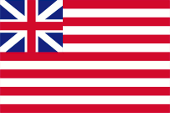
1776–1777,
Grand Union Flag,
Source, by: Corel Draw 4






1775–1800,
parallelly valid variant,
Source, by: Corel Draw 4




The Grand Union Flag was used until 14th of July in 1777, when it was decided by Congress that stars should appear in the canton, the number of which and the number of stripes should correspond to those of the members of the Confederacy. Thus, the British flag was removed from the upper corner and replaced by a blue field with thirteen white stars. According to legend, the first flag was made by Betsy Ross on behalf of George Washington. However, it is not known exactly what the flag looked like, as it has not survived. The text of the law also did not specify how the stars were to be arranged, as it only referred to a "new constellation". The thirteen white five-pointed stars may have been arranged in a circle or in several rows. In the first known depiction from 1778 or 1779, the stars are arranged in a row. It is also not known today why the Union Jack was replaced by a "new constellation" in the first place. In any case, this effective combination of stars and stripes was imitated all over the world. Before the creation of the Stars and Stripes, practically no flag had stars. Since then, they have been found on thousands of flags.
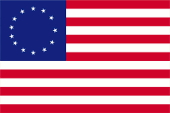
1777–1795,
first "Stars and Stripes", possible variant,
Source, by: Corel Draw 4




1777–1795,
first "Stars and Stripes", possible variant,
Source, by: Corel Draw 4




By the time Vermont and Kentucky became members of the Confederacy (1791/1792), the number of stars and stripes had increased to fifteen since 1st of May in 1795. In the following years, no change to the flag was adopted by Congress, although the number of members continued to increase. The production of new flags was too expensive. In addition, there was a danger that the flag could lose its recognisability if there were a large number of horizontal stripes, especially on the open sea. In 1818, Congress therefore adopted the principle that the number of stripes should revert to the original thirteen. The number of stars, on the other hand, could be increased, but always on 4 July, the day of independence. On 4th of July in 1818, therefore, the third official American flag with twenty stars in the canton was adopted.
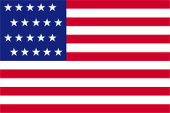
1818,
National flag of the USA,
Source, by: Corel Draw 4




This practice has been maintained ever since, and the present flag is the 28th in succession. Regulations for the design of the flag were issued in 1912, and for the colours in 1934. The exact arrangement of the stars is redefined each time new stars are added, which in more recent times have always been in a row. In today's blue upper corner, there are fifty stars arranged in nine rows. In five of these rows there are six stars and in four rows there are five stars. Each union state has a flag, a seal and a state emblem, for example a bird, a tree or a flower. The flags have different origins and were created at different times.
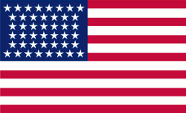
1891–1896,
National flag of the USA,
Source, by: Corel Draw 4



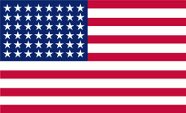
1912–1959,
National flag of the USA,
Source, by: Corel Draw 4




Other historically important flags:
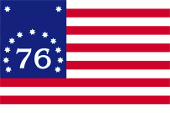
1812, 1826, 1876, (?),
"Bennington Flag" / "Fillmore Flag",
Commemorative flag of the Battle of Bennington 1776,
Source, by: Corel Draw 4,
Wikipedia (EN)





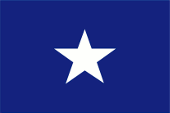
"Bonnie Blue Flag",
1810 – West Florida Republic,
Source, by: Corel Draw 4






Source:
Die Welt der Flaggen,
Flaggen Wappen Hymnen,
Volker Preuß

![]()

























